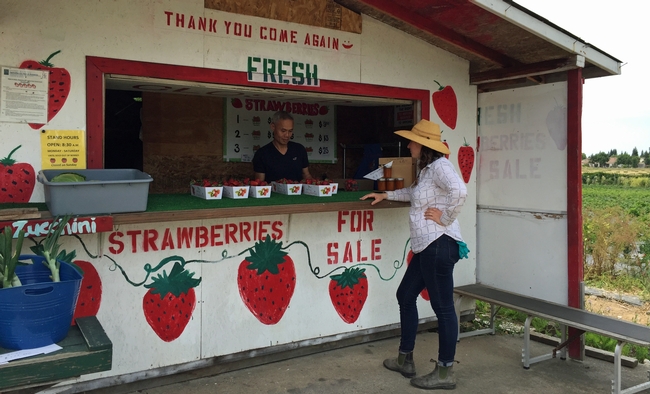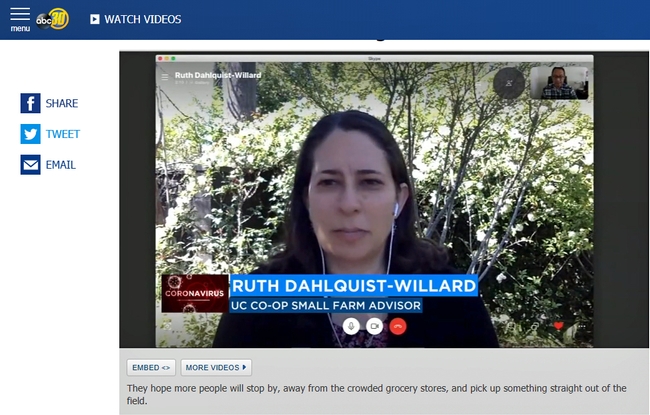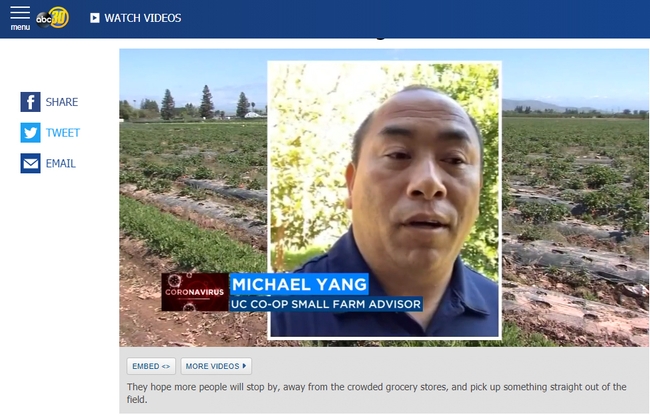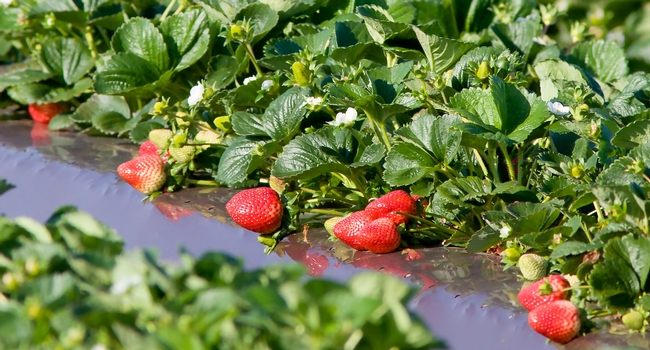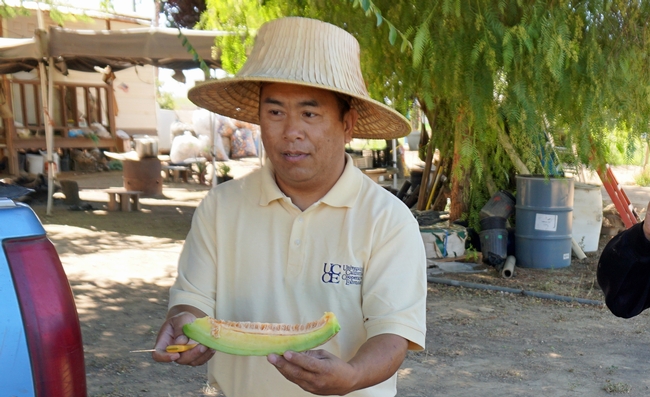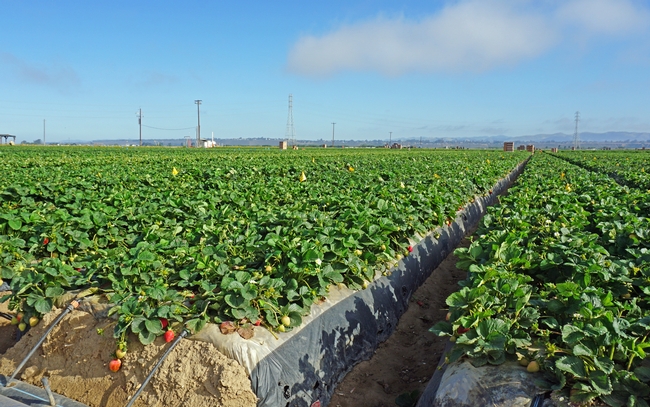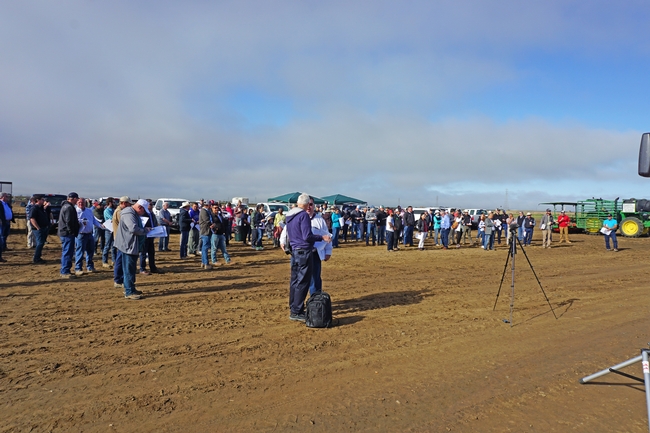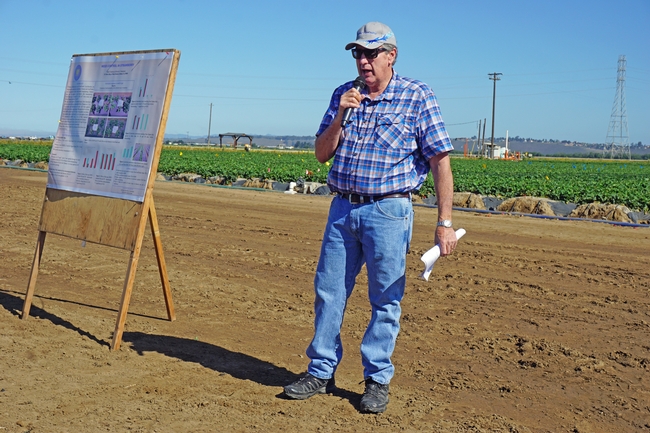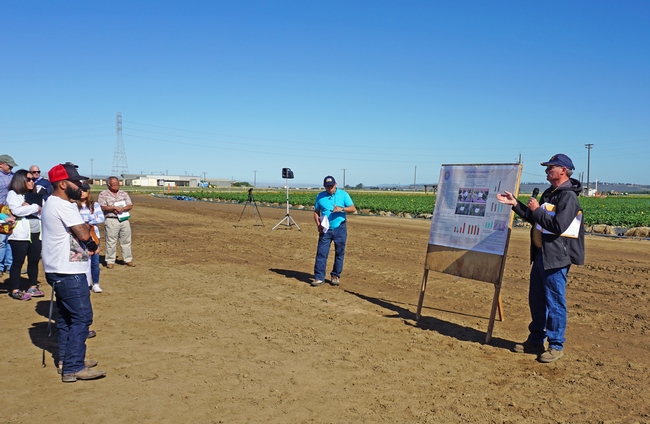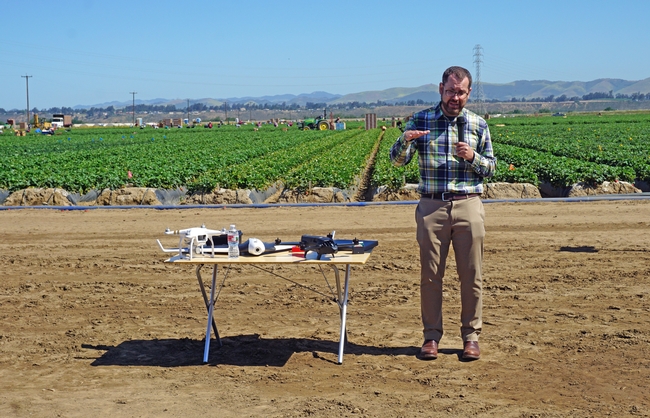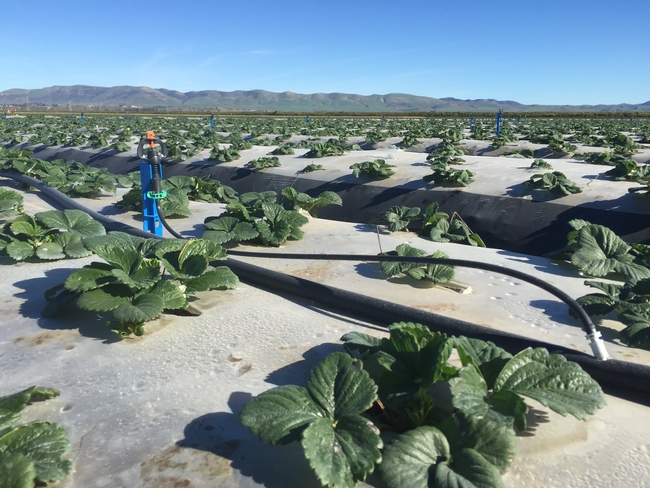Posts Tagged: strawberries
Strawberry farm stands are gearing up for the 2020 season
Road side stands selling fresh strawberries and vegetables are opening up around the San Joaquin Valley, and are a excellent option for safe shopping, reported Dale Yurong on ABC 30 News in Fresno.
In keeping with social distancing guidelines, Yurong conducted remote interviews with UC Cooperative Extension advisor Ruth Dahlquist-Willard and agricultural assistant Michael Yang, who work closely with small-scale farmers in Fresno and Tulare counties.
Dahlquist-Willard suggested customers maintain a six-foot space from other shoppers at farm stands and follow other common sense precautions when purchasing the healthful fresh food by, "not touching any produce that you're not planning to buy, leaving as soon as you've made a purchase and washing the produce when you get home . . . . Similar to what we're seeing at farmers markets right now."
Some valley farmers have been selling their produce at farmers markets out of town and have noticed fewer people are out shopping, Yurong said. They hope more people will stop by the local farm stands, away from the crowded grocery stores, and pick up something straight out of the field.
"My farmers that go to farmers markets, even though the farmers market is still open, they only allow a few people at a time. You don't have a lot of customers walk by just like before," Yang said.
San Joaquin Valley strawberry stands were all expected to be open by April 10, Yurong said.
COVID-19 not a current threat to the food system, but California farmers still feel the pinch
COVID-19 does not currently pose major threats to overall global food security because adequate stores of staples — like wheat and rice — remain available. But the sustainability of California specialty crops may face greater hurdles, reported Laura Poppick in Scientific American.
Poppick spoke with two UC Agriculture and Natural Resources (UC ANR) scientists for perspective on the future of California agriculture considering the market and production constraints posed by measures to slow the spread of the coronavirus.
“Everybody is scrambling to figure out what to do,” said Gail Feenstra, deputy director of UC ANR's Sustainable Agriculture Research and Education Program. “There's just a lot of disruption.”
Specialty products — such as some fruits and organic produce grown on smaller-scale farms — are often sold to restaurants and farmers markets, many of which are now closed or have reduced service, rather than directly to the grocery stores that are still operating. Even if these farmers are able to continue working, they may have limited places to sell their goods, the article said.
Strawberries are another crop likely to be affected. Laborers picking strawberries typically work more closely than is advisable to prevent the spread of the virus, said Mark Bolda, a University of California Cooperative Extension farm advisor based in Watsonville. He said farmers are already making plans to spread workers between rows.
Strawberries, however, hit prime ripeness within a narrow window of just two to three days and must be picked quickly, Bolda says. Spacing workers may slow picking, and, "being slower is expensive."
Rainy winter is good news for Central Valley strawberries
Abundant rainfall in January and February 2019 bodes well for the forthcoming Central Valley strawberry season, reported Reuben Contreras on ABC Channel 30 Action News in Fresno.
Contreras interviewed Michael Yang, small farms and specialty crops Hmong agricultural assistant with UC Cooperative Extension.
"We need the water as much as we can right now," Yang said. He said the rain will add to the groundwater supply most farmers use to grow their crops, plus it will make the strawberries sweeter.
Cool weather is also welcome.
"Strawberries need cool weather but in the summer, the hot weather with the variety strawberries will not survive the heat," he said.
In the San Joaquin Valley, strawberries are picked from late March to early June. If the wet weather pattern established in January and February continues through the spring, that could spell trouble for strawberry farmers. Wet strawberries can rot in the field.
Probiotics for plants: A new frontier for boosting crop production
The strawberry industry ended a long good-bye to methyl bromide in 2016. The fumigant had been used for decades to kill a wide range of soil-borne pathogens, weed seeds and insects, permitting the California strawberry industry to flourish. Scientists determined it was an ozone-depleting chemical in 1991, but its phase-out was delayed for years because of lack of equally effective alternatives.
Strawberry farmers now use a combination of approaches, including fumigation with other chemicals, soil oxygen deprivation, biofumigants, and beneficial microbes that improve soil biology. A greater arsenal is needed.
“Growers have three or four chemical alternatives, some are used alone and others in various combinations,” said UC Cooperative Extension advisor Surendra Dara. “Now, certain minerals, beneficial microbes and biostimulants are becoming available to enhance plant's natural defenses and improve strawberry growth, yield and health in an era without methyl bromide.”
Dara conducts research and advises strawberry and vegetable growers in the Central Coast counties of San Luis Obispo and Santa Barbara. Each year he holds a field day that attracts nearly 200 farmers, pest control advisers and representatives of allied industries to Manzanita Berry Farms outside Santa Maria. The agenda for the May 9 event included preliminary results of trials studying a number of commercially available and soon-to-be available biological and synthetic amendments to improve strawberry plant health, berry quality and yield.
Dara was ill, so Manzanita Farm owner Dave Peck reviewed the handout prepared by Dara for the field day. Manzanita Farms is one of two sites where Dara is testing products in replicated plots. Other studies are conducted in strawberries grown at the Shafter Research Station, a privately managed agricultural research facility in Kern County.
Several products resulted in increased marketable yield of strawberries during the February 2018 to April 2018 study period. See the preliminary results here. Data collection will continue through the end of the strawberry season.
“A challenge was that many people did not have complete faith in biologicals a few years ago,” Dara said. “By conducting multiple studies year after year, we are able to generate critical data that is useful for the farmers as well as companies that produce biologicals. By using different application strategies and rates, and a combination of techniques - as appropriate for their situations - farmers can engage in sustainable strawberry production.”
Farmers can use micro-sprinklers in strawberries to cut water use
Each fall, strawberry farmers put young strawberry transplants in the ground through holes cut in plastic mulch. Beneath the mulch are drip lines that will serve to irrigate the plants as they reach maturity. But early on, farmers typically install solid-set aluminum sprinklers in the furrows to get the plants started and leach salts below the strawberry plants' root zone.
“In some areas, overhead aluminum sprinkler irrigation is considered very important to prevent dry conditions which could result from Santa Ana winds,” Dara said. “However, the aluminum sprinkler irrigation requires a significant amount of water and can be inefficient.”
During the 2014-15 strawberry season, Dara worked with farmer Dave Peck of Manzanita Berry Farms in Santa Maria to compare micro-sprinklers with the more commonly used aluminum sprinkler systems. The experimental plots were planted in early November and carefully monitored throughout the growing and harvest season, which ended in June. The two types of sprinkler irrigation were used for about one month, then the grower switched to using exclusively the drip irrigation installed underneath the mulch.
Dara found that micro-sprinkler irrigation cut water use by 32 percent compared to the area where aluminum sprinklers were used, and resulted in no significant difference in total marketable yield.
Strawberry plant vigor was measured each month during the study. At first, the plants in the micro-sprinkler treatment area were significantly smaller, but they caught up with the rest by March. Sprinkler irrigation is also thought to help control twospotted spider mites and predatory mites. In Dara's experiment, however, the pests' sparse numbers did not allow for useful data to be collected.
The sprinkler comparison did offer insight on powdery mildew, a serious disease problem, particularly for organic strawberry growers. Sampling for powdery mildew in the plots showed that its severity was significantly less in the micro-sprinkler treatment. Another common strawberry production problem, botrytis fruit rot, was also eased with the micro-sprinkler treatment.
RDO Water and Netafim were partial funders of the project.
The full research report is posted on Dara's eNewsletter.
An initiative to improve California water quality, quantity and security is part of the UC Division of Agriculture and Natural Resources Strategic Vision 2025.
Author: Jeannette Warnert


